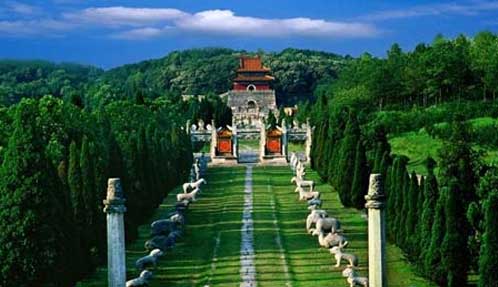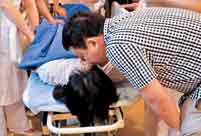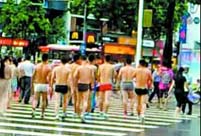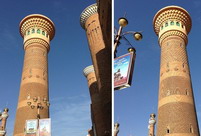 Air Forces arrive at designated area to join China-Russia drill
Air Forces arrive at designated area to join China-Russia drill
 High temperature hits Shanghai
High temperature hits Shanghai
 Old town Dali hosts int'l photography exhibition
Old town Dali hosts int'l photography exhibition
 Death toll rises to 29 in rain-related accidents across Pakistan
Death toll rises to 29 in rain-related accidents across Pakistan
 Baby returned to parents after allegedly being trafficked
Baby returned to parents after allegedly being trafficked
 Nutrica recalls Karicare infant formula in New Zealand
Nutrica recalls Karicare infant formula in New Zealand
 Sexy models in CFGP race
Sexy models in CFGP race
 Child labor still remains rampant in war-hit Afghanistan
Child labor still remains rampant in war-hit Afghanistan
 Sun Yang the star of last day at World Swimming Championships
Sun Yang the star of last day at World Swimming Championships
 |
| Ming Xiaoling Mausoleum (file photo) |
Ming Xiaoling Mausoleum
Zhu Yuanzhang (1328-1398), the Emperor Hongwu, first emperor of Ming Dynasty, was the most influential emperor in Nanjing’s history as China’s capital. He chose scenic Zhongshan (Zhong Mountain), only 5 kilometers from today’s downtown Nanjing, as the place he would rest after his death.
Departing from the city center, it takes only about 20 minutes to reach the forests of Zhongshan. With the 600-year-old city wall (also built by Zhu Yuanzhang) on one side of the road and tall pine trees on the other, the trip to Ming Xiaoling Mausoleum itself was relaxing and refreshing. Meihua Mountain (Plum Blossom Mountain), near Ming Xiaoling and inside the Zhongshan Hill Scenic Area, is one of the most popular places in China to enjoy spring plum blossoms from February to March, offering its natural beauty to the emperor’s final resting place all year long.
After entering the serene entrance of Ming Xiaoling, I found myself standing in front of the 1,800-meter-long Shendao, or Sacred Way. All the other sacred ways in Chinese emperors’ mausoleums are straight and direct, but the one in Ming Xiaoling has a curving shape, looking like a large “C” and divided into two parts, the Elephant Road and the Wengzhong Road. The reason for the deviation from the common standard goes back some 1,700 years: it was built around the tomb of the city’s first emperor, Sun. Zhu Yuanzhang decided not to follow the principle when he built his own tomb, in order to show respect to Sun Quan, who he regarded as a hero. So today, whoever wants to visit Ming Xiaoling must pass Sun’s tomb first.
Twelve pairs of six kinds of animals — lions, xiezhi (mythological animals with a lion’s body and sometimes a unicorn-like horn), camels, elephants, qilin (mythical hooved creatures) and horses, and four pairs of ministers and generals, all carved from enormous stones — guard the way to the emperor’s tomb. Their simple lines and serene expressions create a quiet and majestic mood.
Many buildings in Ming Xiaoling, such as the main Sacrificial Hall, were destroyed in the wars during Taiping Rebellion and rebuilt in the late Qing Dynasty and modern times. According to the stone foundation from the Ming Dynasty that is still visible, what we can see today covers less than one fourth of the original buildings. Fortunately, the 16-meter-tall wall in front of the tomb is still well kept after 600 years.
Climbing onto the top of the wall, which has a similar structure to the city walls in Nanjing, visitors can get a bird’s-eye view of the whole area. Take a deep breath of the fresh air and look back to the mountain at the trees. Zhu Yuanzhang was buried under those trees, deep in the mountain.
Since the city suffered from times of war from the late Qing Dynasty to the middle of the 20th century, many historic sites in Nanjing were burned to ground and no longer exist. The most important evidence of the historic capital city might be its city walls and the tomb of Zhu Yuanzhang and his empress, never opened or even touched in more than 600 years. The Ming Xiaoling Mausoleum is part of the UNESCO World Heritage site Imperial Tombs of the Ming and Qing Dynasties.
 |  |
 Air Forces arrive at designated area to join China-Russia drill
Air Forces arrive at designated area to join China-Russia drill  Hospital comes to aid of tragic family of ‘Chinese Cabbage Dad’
Hospital comes to aid of tragic family of ‘Chinese Cabbage Dad’ Czech artist performs bubble show at Hong Kong mall
Czech artist performs bubble show at Hong Kong mall  Italian Supreme Court confirms Berlusconi's jail verdict
Italian Supreme Court confirms Berlusconi's jail verdict Run naked as punishment for missing sales target
Run naked as punishment for missing sales target International Grand Bazzar in Urumchi,Xinjiang
International Grand Bazzar in Urumchi,Xinjiang  Chinese troops of "Peace Mission - 2013" arrive at exercise area
Chinese troops of "Peace Mission - 2013" arrive at exercise area Pakistan's rain-triggered accidents claim 29 lives: media
Pakistan's rain-triggered accidents claim 29 lives: media Anti-hijacking drill held on train in Wuhan
Anti-hijacking drill held on train in Wuhan Top 10 most dangerous jobs in the world
Top 10 most dangerous jobs in the world Zhang Ziyi graces Femina magazine
Zhang Ziyi graces Femina magazine Breathtaking images of extreme sports
Breathtaking images of extreme sportsDay|Week|Month